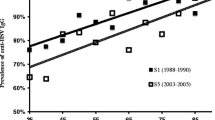Abstract
Objectives: To evaluate if different levels of human herpesvirus 6 (HHV-6) antibodies can predict HIV disease progression. Design: Longitudinal study of individuals with a documented date of HIV seroconversion. Setting: Clinical centers located throughout Italy. Patients: Individuals who serconverted for HIV between 1983 and 1995 in Italy. Methods: Sera were tested for IgG antibodies to HHV-6 using a commercial enzyme immunoassay. A serum sample with an optical density (OD) ≥ 242 (i.e. the mean value of 10 negative controls+ 4×standard deviation) was considered as HHV-6 positive; the progression of HIV disease was evaluated estimating the relative hazards (RH) of AIDS (by Cox models) for individuals with higher levels vs. lower levels of HHV-6 antibodies or considering levels of antibodies based on 10% increase of the distribution (deciles). Rates of CD4 decline fitting linear regression were also estimated. Results: A total of 381 persons were followed for a median time of 4 years (range: 0.15–9 years) following the date of collection of the serum sample. The median OD value of HHV-6 antibodies was 306, with an interquartile range of 241–440 and a range of 48–2330. A slight inverse correlation was found between HHV-6 antibody levels and age of the individual at the time of serum collection (Spearman rank correlation coefficient, −0.16; p = 0.0013). No association was found between HHV-6 and CD4 level or between HHV-6 and CD8 level at the date of serum collection. The unadjusted RH of progression to AIDS was 0.63 (95% CI: 0.42–0.96) for HHV-6 positive individuals vs. HHV-6 negative; when adjusting for possible confounders (CD4, age, pre-AIDS HIV-related pathologies at the date of sera collection, and previous anti-herpes treatment), the RH of AIDS increased to 0.80 (95% CI: 0.51–1.23). No particular association with HIV disease progression was found when using the deciles of the distribution of HHV-6 antibodies. The median CD4 cell loss was 5.0 × 106 cells/l per month among HHV-6 positive individuals and 5.7 × 106 cells/l per month among the others. Conclusions: The presence of high levels of HHV-6 antibodies does not seem to predict the clinical or immunologic progression of HIV disease.
Similar content being viewed by others
References
Lusso P, Markham PD, Tschachler E, et al. In vitro cellular tropism of Human B-lymphotropic virus (human herpesvirus-6). J Exp Med 1988; 167: 1659–1670.
Ensoli B, Lusso P, Schachter F, et al. Human herpesvirus-6 increases HIV-1 expression in coinfected T cells via nuclear factors binding to the HIV-1 enhancer. EMBO J 1989; 8: 3019–3027.
Lusso P, Ennsoli B, Markham PD, et al. Productive dual infection of human CD4+ T lymphocytes by HIV-1 and HHV-6. Nature 1989; 337: 370–373.
Lusso P, De Maria A, Malnati M, et al. Induction of CD4 and susceptibility to HIV-1 infection in human CD8+ T lymphocytes by human herpesvirus-6. Nature 1991; 349: 533–535.
Carrigan DR, Harrington D, Knox KK. Variant A human herpesvirus six as a cofactor in the pathogenesis of AIDS. J of Acquir Immune Defic Syndr 1996; 13: 97–98.
Lusso P, Gallo RC. Human herpesvirus-6 in AIDS. Lancet 1994; 343: 555–556.
Chen H, Pesce AM, Carbonari M, et al. Absence of antibodies to human herpesvirus-6 in patients with slowly-progressive human immunodeficiency virus type 1 infection. Eur J Epidemiol 1992; 8: 217–221.
Valle Balsquez M, Madueño JA, Jurado R, Fernández-Arcás, and Muñoz E. Human Herpesvirus-6 and the course of human immunodeficiency virus infection. J of Acquir Immune Defic Syndr 1995; 9: 389–394.
Spira TJ, Bozeman LH, Sanderlin KC, Warfield DT, et al. Lack of correlation between Human Herpesvirus-6 infection and the course of Human Immunodeficiency virus infection. JID 1990; 161: 567–570.
The Italian Seroconversion Study. Disease progression and early predictors of AIDS in HIV-seroconverted injecting drug users. AIDS 1992; 6: 421–426.
Rezza G, Lazzarin A, Angarano G, et al. Risk of AIDS in HIV seroconverters; a comparison between intravenous drug users and homosexual males. Eur J Epidemiol 1990; 6: 99–101.
Ancelle-Park R. Expanded European AIDS case definition. Lancet 1993; 341–441.
Nicolosi A. HIV epidemiology, models and methods. New York: Raven Press, 1994.
Lee ET. Statistical methods for survival data analysis. New York: John Wiley &; Sons, 1992.
Cermelli C, Moroni A, Pietrosemoli P, et al. IgG antibodies to human herpesvirus-6 (HHV-6) in Italian people. Microbiologica 1992; 15(1): 57–63.
Brown NA, Sumoyo CV, Lin CR, et al. Fall in human herpesvirus 6 seropositivity with age [Letter]. Lancet 1988; 396.
Author information
Authors and Affiliations
Rights and permissions
About this article
Cite this article
Dorrucci, M., Rezza, G., Andreoni, M. et al. Serum IgG antibodies to human herpesvirus-6 (HHV-6) do not predict the progression of HIV disease to AIDS. Eur J Epidemiol 15, 317–322 (1999). https://doi.org/10.1023/A:1007503018729
Issue Date:
DOI: https://doi.org/10.1023/A:1007503018729




